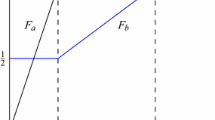Abstract
This paper studies the investment in a group with stickiness. A group investment game is constructed. By analyzing the best response of each player, the equilibria are presented. Furthermore, the convergence region of each equilibrium is outlined, and the sensitivity analysis of the region to parameters is explored. The game with two players is given to illustrate the convergence region of each equilibrium. The explanation and illustration of the results are summarized. The findings indicate that a successful investment usually occurs in a group with “tolerance”, “open-sharing”, “efficiency”, “sensitivity”, and with large members.

Similar content being viewed by others
References
Deets, M.K., George, C.H.: Variance preferences and variance shifts in group investment decisions. Organ. Behav. Hum. Perform. 5, 378–386 (1970)
Florack, A., Juliane, H.: Regulatory focus and investment decisions in small groups. J. Exp. Soc. Psychol. 43, 626–632 (2007)
Cheng, P., Chiou, W.: Framing effects in group investment decision making: role of group polarization. Psychol. Rep. 102, 283–292 (2008)
Van de Kragt, A.J.C., Orbell, J.M., Dawes, R.M.: The minimal contributing set as a solution to public goods problems. Am. Polit. Sci. Rev. 77, 112–122 (1983)
Van Vugt, M., De Cremer, D.: Leadership in social dilemmas: the effects of group identification on collective actions to provide public goods. J. Pers. Soc. Psychol. 76, 587–599 (1999)
Van Vugt, M., De Cremer, D.: Leader endorsement in social dilemmas: comparing the instrumental and relational perspectives. Eur. Rev. Soc. Psychol. 13, 155–184 (2003)
Nash, J.: Non-cooperative game. Ann. Math. 54, 286–295 (1951)
Sherif, M.: The Psychology of Social Norms. Harpe, New York (1936)
Asch, S.E.: Opinions and social pressure. Sci. Am. 193, 31–35 (1951)
Fudenberg, D., Tirole, J.: Game Theory. The MIT Press, London (1991)
Matsui, A.: Best response dynamics and socially stable strategies. J. Econ. Theory 57, 343–362 (1992)
Fudenberg, D., Levine, D.K.: The Theory of Learning in Games. The MIT Press, London (1998)
Author information
Authors and Affiliations
Corresponding author
Additional information
Communicated by Irinel Chiril Dragan.
This work was partially supported by the Natural Science Foundation of Zhejiang University of Technology (No. 2011XY006), National Natural Science Foundation of China (Grant No. 70971118) and Foundation of Zhejiang Educational Committee (No. Y201121675).
Appendices
Appendix A: Proof of Theorem 2.2
Without any loss of generality, consider player i∈N. Then \(\overline{x_{-i}^{*}}=1\geq \frac{d-1}{n-1}\). It follows from (12) that \(\mathrm{BR}_{i}(\boldsymbol{x}^{*}_{-i})= \mathrm{BR}_{i\_\mathrm{B}}(\boldsymbol{x}^{*}_{-i})\) if \(\overline{x_{-i}^{*}}< \frac{d}{n-1}\), and \(\mathrm{BR}_{i}(\boldsymbol{x}^{*}_{-i})=\mathrm{BR}_{i\_\mathrm{A}}(\boldsymbol{x}^{*}_{-i})\) if \(\overline{x_{-i}^{*}}\geq \frac{d}{n-1}\).
In the case \(\overline{x_{-i}^{*}}< \frac{d}{n-1}\), we have \(u_{i}(\mathrm{BR}_{i\_\mathrm{B1}}(\boldsymbol{x}^{*}_{-i}),\boldsymbol{x}^{*}_{-i})\leq 0\), \(\mathrm{BR}_{i\_\mathrm{B2}}(\boldsymbol{x}^{*}_{-i})=1\) and \(u_{i}(1,\boldsymbol{x}^{*}_{-i})=n\alpha k-1\geq 0\). Therefore, it follows from (10) that \(\mathrm{BR}_{i\_\mathrm{B}}(\boldsymbol{x}^{*}_{-i})=\mathrm{BR}_{i\_\mathrm{B2}}(\boldsymbol{x}^{*}_{-i})=1\). Thus,
In the case \(\overline{x_{-i}^{*}}\geq \frac{d}{n-1}\), we have \(\mathrm{BR}_{i\_\mathrm{A}}(\boldsymbol{x}^{*}_{-i})=\min \{\frac{\alpha k-1}{2\beta}+\overline{\boldsymbol{x}^{*}_{-i}}, 1 \}=1\). Thus,
To sum up, \(u_{i}(1,\boldsymbol{x}^{*}_{-i})\geq u_{i}(x_{i},\boldsymbol{x}^{*}_{-i}),\ \forall x_{i}\in[0,1]\).
In conclusion, the strategies \((x^{*}_{1},x^{*}_{2},\ldots,x^{*}_{n})\) are a Nash equilibrium, where for any i∈N, \(x^{*}_{i}=1\).
Appendix B: Proof of Theorem 2.3
Without any loss of generality, consider player i∈N. Since d>1, then \(\overline{x_{-i}^{*}}=0<\frac{d-1}{n-1}\). It follows from (12) that \(\mathrm{BR}_{i}(\boldsymbol{x}^{*}_{-i})=\mathrm{BR}_{i\_\mathrm{C}}(\boldsymbol{x}^{*}_{-i})= \max \{\overline{\boldsymbol{x}_{-i}}-\frac{1}{2\beta}, 0 \}=0\). That is,
In conclusion, the strategies \((x^{*}_{1},x^{*}_{2},\ldots,x^{*}_{n})\) are a Nash equilibrium, where for any i∈N, \(x^{*}_{i}=0\).
Appendix C: Proof of Theorem 2.4
For any \(\boldsymbol{x}\in S_{\mathbf{1}}^{(1)}\), we have \(\overline{\boldsymbol{x}_{-i}}\geq \frac{d}{n-1}\). Let x (0)=x, x (t) be given in Definition 2.1, and \(K^{(t)}:= \{i\mid \mathrm{BR}_{i} (\boldsymbol{x}_{-i}^{(t-1)} )<1 \}\). If i∈K (1), then \(x_{i}^{(1)}= \overline{\boldsymbol{x}_{-i}^{(0)}}+\frac{\alpha k-1}{2\beta}\geq \frac{d}{n-1}+\frac{\alpha k-1}{2\beta}\). Thus, for any i∈N, we have
where |⋅| measures the number of members of a set, K (1)∖{i} denotes the set K (1) excluding the member i. Iteratively, we have
Therefore, when |K (t)|≥2, for any i∈N, the lower bound of \(\overline{\boldsymbol{x}_{-i}^{(t)}}\) is increasing with respect to t, and the increasing step Δ satisfies \(\Delta\geq \frac{\alpha k-1}{2(n-1)\beta}>0\). Since \(\overline{\boldsymbol{x}_{-i}^{(t)}}\leq 1\) holds for all t>0, therefore, there exists a T 1, when t>T 1, we have |K (t)|<2. Otherwise, there exists an i such that \(\overline{\boldsymbol{x}_{-i}^{(t)}}> 1\), which contradicts \(\overline{\boldsymbol{x}_{-i}^{(t)}}\leq 1\). When t>T 1 and |K (t)|=1, suppose K (t)={i}, it follows from (17) that the lower bound of \(\overline{\boldsymbol{x}_{-i}^{(t)}}\) is unchanged, while, for any j∈N and j≠i, the lower bound of \(\overline{\boldsymbol{x}_{-j}^{(t)}}\) is increasing. Thus, there exists a T 2, when t>T 2, |K (t)|=0, i.e., K (t)=ϕ, meaning that for any i∈N, \(x_{i}^{(t)}=1\). Therefore, x∈D(1). Thus, \(S_{\mathbf{1}}^{(1)}\subseteq D({\mathbf{1}})\).
Similarly, we have \(S_{\mathbf{0}}^{(1)}\subseteq D({\mathbf{0}})\).
Rights and permissions
About this article
Cite this article
Wang, C., Deng, L. Game Analysis of Investment in a Group with Stickiness. J Optim Theory Appl 155, 1047–1059 (2012). https://doi.org/10.1007/s10957-012-0108-4
Received:
Accepted:
Published:
Issue Date:
DOI: https://doi.org/10.1007/s10957-012-0108-4



